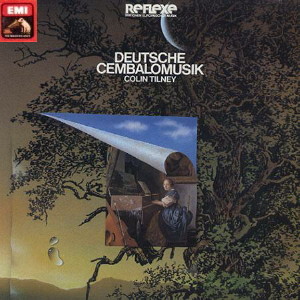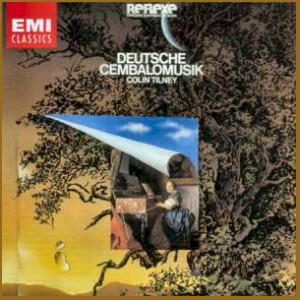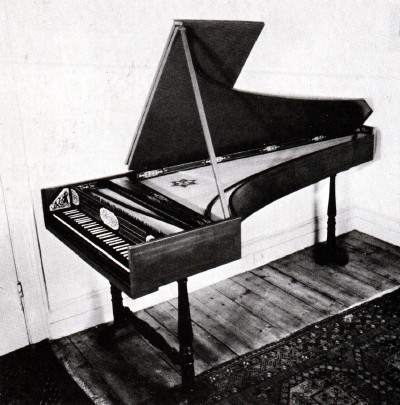 |
1 LP -
1C 069-46 406 - (p) 1982
|

|
| 1 CD - 8
26528 2 - (c) 2000 |
|
| DEUTSCHE CEMBALOMUSIK |
|
|
|
|
|
| Georg Böhm
(1661-1733) |
|
|
| - Praeludium,
Fuga und Postludium g-moll |
8' 04" |
|
| - Suite Nr. 6
Es-dur - (Allemande · Courante
· Sarabande · Gigue) |
9' 54" |
|
| Johann Kuhnau (1660-1722) |
|
|
| -
Suonata quarta c-moll "Hiskias
agonizzante" |
7' 34" |
|
|
|
|
| Johann
Pachelbel (1653-1706) |
|
|
| - Aria quinta
a-moll (aus "Hexachordum
Apollinis") |
7' 02" |
|
| Georg Böhm
(1661-1733) |
|
|
| -
Capriccio D-dur |
4' 59" |
|
| Johann Sebastian Bach
(1685-1750) |
|
|
| -
Fantasie und Fuge a-moll, BWV 904 |
9' 46" |
|
|
|
|
| Colin
Tilney, Cembalo
(einmanualig con Christopher
Nobbs, nach einem angeblich
suddeutschen Cembalo im Courtauld
Institute, London) |
|
|
|
| Wir
danken Herrn Jacques Ogg, daß er und
das Instrument für diese Aufnahme
zur Verfügung stellte. |
|
|
|
|
|
Luogo
e data di registrazione |
|
London
(Inghilterra) - 1978/1979 |
|
|
Registrazione: live /
studio |
|
studio |
|
|
Producer / Engineer |
|
Lucy
Robinson / Colin Tilney / Adam
Skeeping / Nic Parker |
|
|
Prima Edizione LP |
|
EMI
Electrola "Reflexe" - 1C 069-46
406 - (1 lp) - durata 48' 09" -
(p) 1982 - Analogico |
|
|
Prima Edizione CD |
|
EMI
"Classics" - 8 26528 2 - (1 cd) -
durata 48' 09" - (c) 2000 - ADD |
|
|
Note |
|
-
|
|
|
|
|
|
 Colin Tilney
plays German Harpsichord
Music Colin Tilney
plays German Harpsichord
Music
History has allotted Georg Böhm the
role of a John the Baptist to
the Jesus of Johann Sebastian
Bach. It is a role he shares with a
number of other composers. In
answer to a question from J. N.
Forkel, Bach’s first
biographer, C. P. E.
Bach wrote of his father's
musical education: “Besides
Froberger, Kerll and
Pachelbel, he heard and
studied the works of
Frescobaldi, the Baden
Capellmeister Fischer,
Strunck, some old and good
Frenchmen, Buxtehude, Reincken,
Bruhns, and the Lüneburg
organist Böhm."
We can see from the obituar
notice of 1754 how justly the
son placed his father above
contemporaries and
predecessors, but Emanuel
clearly did not underestimate
these men whose music had
formed Bach’s taste and
skills: the first three he
calls “the most famous masters
of the day” and Böhm he
actually names as Bach’s
‘teacher’ in Lüneburg
although he later had second
thoughts and crossed the word
out. The adolescent chorister
at the Michaels-Gymnasium
and the established organst of
the nearby Johanniskirche may
not have been formally master
and pupil, but there must have
been contact and there was
certainly influence. History’s
liking for simple tendencies
and definitive end-products
has occasionally to be checked
and turned about, so that
prophets become messiahs for a
day and Böhm’s
splendid music can be heard
without prejudice or
comparison.
A Thuringian like Bach, Böhm
spent most of his thirties in
the important cosmopolitan
city of Hamburg (a town that
Emanuel associates
specifically with the French
style in the forming of his
fatherßs experience). In 1698
Böhm
moved to Lüneburg,
where he remained until his
death in 1733. Although he wrote
many cantatas and sacred
songs, Böhm
is chiefly remembered for his
keyboard music - preludes and
fugues for the organ, French
suites for the harpsichord,
and chorale variations for
both instruments. He
published nothing, and the
various manuscript sources of
his works, usually without
concordance, are unreliable in
text and perhaps also in
ascription. The fifth suite in
the collected edition has now
been firmly attributed to
Froberger; conversely, genuine
pieces by Böhm
may still be awaiting
discovery or correct
assignment. Under these
circumstances judgment of Böhm’s
achievement seems unwise, but
a special and quite
distinctive voice can surely
be heard in most of the
harpsichord music - inventive,
passionate, mercurial,
sometimes witty, given to
harmonic daring and often
drawing on the syncopation
techniques of the French
lutenists. The sixth suite is
a case in point. Froberger
would have enjoyed the gigue
subject and the flat-sharp
contrasts in the allemande and
courante, but his parts never
explore such simultaneous
heights and depths as Böhm’s,
nor could they manage such
rushes and teases as Böhm
writes in the courante and
gigue. The form and the
general treatment of ideas
certainly come from Froberger,
the first
great German importer of the
French dance suite for
keyboard, but Böhm’s
spare textures and memorable
turns of phrase mark out his
suites, not only from the
source, but also from the
dozens of contemporary
imitations that can be found
in the manuscripts and prints
of the period. The only
composer of that generation
who at times matches Böhm’s
invention is J. C. F. Fischer,
and he takes far fewer risks.
Gerber put in fairly in his
lexicon of 1812: “Not
only was Georg Böhm an
accomplished organist, but his
taste must have been formed
after the music of greater
writers. He
treats melodies and subsidiary
voices so fluently and
agreeably that his work
stands out in high relief from
the stiff and uningratiating
routine production of his
time".
If the
beautiful and little known E
flat suite represents Böhm's
contribution to keyboard
music in the French style,
the D major
Capriccio shows his
indebtedness to Italy, again
through the Germanizing
influence of Froberger, who
had studied with Frescobaldi
in Rome
between 1637 and 1641 and
modelled his contrapuntal
writing on that of the great
organist of St. Peter’s. In 1624
Frescobaldi had published a
collection of twelve capricci,
intending them to be a kind of
handbook of contrapuntal
variation in a less strict
imitative style than that
called for by the ricercar or
the fantasia: such subjects as
the ascending and descending
hexachord, short snatches of
popular song, suspension and
discord, even the two-note
ostinato of the cuckoo, are
taken and woven into brilliant
fugal compositions, full of
invention and wit. Böhm’s
little capriccio is on a more
modest scale, but nonetheless
perfectly shaped and
controlled. Following
Froberger, Böhm
reduces Frescobaldi’s numerous
small sections to just three,
rounds off each section with a
free cadenza and, by means of
rhythmic and chromatic
alteration, turns his simple
though, attractive subject
into a tour de force
of virtuoso excitement.
Finally, in his remaining work
recorded here, the Praeludium,
Fuga and Postludium, Böhm
ventures out without the
helping hand of Froberger and
creates a masterpiece that has
no equal anywhere in
harpsichord literature. A
French operatic chaconne as
prelude to a fugue would be
innovation enough, but Böhm
seems not content with this
one act of pioneering: he
follows his fugue with an
inspired chain of falling
sevenths, interrupted by
dramatic silences, before
bringing the music to rest
easily and quietly in the home
key of G minor. The prelude
and fugue breathe fire and
solemnity, but the third part
is utter magic, joy alike to
audience and performer; surely
it is some such happily
remembered and transformed
improvisation at the keyboard
that lies behind an even
greater work, Bach’s Chromatic
Fantasy.
The collections from which the
pieces by Kuhnau and Pachelbel
come were published within a
couple of years of each other,
the Biblical Sonatas in 1700 and
the Hexachordum
Apollinis in 1699.
Kuhnau is Bach’s most famous
forerunner, in the limited
sense that he preceded Bach as
Cantor in the Leipzig
Thomaskirche, but his rich and
varied talents as
mathematician, lawyer,
linguist and philosopher are
nowadays as forgotten as his
music (Matthew Locke and Henry
Purcell offer a strangely
exact parallel). Yet Scheibe
ranked Kuhnau with Keiser,
Telemann and Handel as one of
the four greatest German
composers of the time, while
Bach and Handel showe their
tacit esteem by studying his
music and taking ideas from it
for their own use. The six
Biblical stories are
attractive examples of
Kuhnau’s imagination and
piety; the sometimes rather
naive musical devices used to
illustrate the text come from
the same tradition as Bach’s
postilions
and thunderstorms. The fourth
History portrays the mortal
illness of Hezekiah and Isaiah’s
message: Thou shalt die and
not live, Hezekiah‘s prayers,
the reversal of the verdict
and Hezekiah’s joy at his
recovery. Kuhnau employs the
Lutheran hymn, Ach, Gott,
mich armen Sünden
to represent Hezekiah’s
suffering and sets a triple
version of the same tune to
translate the proportional
gift of fifteen years life for
the ten lost sundial hours;
between these to settings
comes a little episode whose
melodic inversion suggests the
shadows running backwards,
and momentary sadness breaks
into the gaiety
of Hezekiah’s
final dance, as the king
remembers his former
sickness. No
such elaborate programme
underlies the lovely
variations by the Nuremburg
organist, Johann Pachelbel,
the oldest of the composers
on the record. Written
throughout in two or three
parts, these six charming
little pieces definitely
give the lie to Gerber’s
somewhat sweeping judgment.
Pachelbel’s variations and
the Böhm
capriccio belong to that
large body of seventeenth-
and eighteenth-century
keyboard music that suits
both organ and harpsichord;
the same can be said also of
the Fantasia and Fugue in A
minor, BWV 904, although the
work is perhaps more often
chosen for recital by
organists. The five-part
writing at the opening and
close of the fantasia
sounds equally impressive on
either instrument and an Italianate
harpsichord such as the one
used for this recording
gains in clarity what it
loses in grandeur to full
organ in the first subject
of the double fugue. Later
on, at the entry of the
second fugue, the sharp
tonal decay of the
harpsichord provides the
ideal match for Bach’s
haunting chromaticism, where
the organ runs the risk of
sounding hard and
unyielding. Players of both
instruments, however, should
be persuaded to take
more delight in this
magnificent work, one of
Bach’s greatest ‘hidden’
masterpieces.
Colin
Tilney,
1980
A Note on the
Instrument
The harpsichord used for
this recording is a precise
replica of an instrument now
in the Courtauld Institute,
London. The maker is
unknown, and at present it
is uncertain where and when
it was built, but details of
the design and construction
and the style of the
unusually elaborate
decoration associate it with
Austria or South Germany in
the last quarter of the
seventeeth century.
Unusually, it has a compass
of five octaves, FF- F3
without FF sharp. The whole
interior and keywell is
covered with marquetry and
outlined with ‘flammleisten’.
The soundboard is of cypress
wood containing a ‘rose’
which is in the form of a
sixpointed star made of
pierced wood and leather.
The instrument was intended
for an outer case, and the
original has been rohousod
at least once in its
history. In the same way as
German-speaking areas often
borrowed their forms of
music from other countries,
particularly Italy and
France, so also the types of
musical instruments were at
first imitated, then with
great variety adapted and
elaborated. Apart from some
Germanic variations, this
harpsichord conforms with
the type that for
convenience we usually call
Italian: short-scaled,
brass-strung, and with two
unison registers. Other
versions of this approach to
harpsichord design are found
in nearly all the European
schools of building. Their
intimate and "vocal" timbre,
less obviously rich than
steelstrung instruments, and
the precise enunciation of
their actions were an
important influence on
keyboard music written
outside of Italy.
A specifically German
feature of this harpsichord
is the separation of the two
registers to exaggerate the
difference in tone quality
between them, so that used
alone each has an exotic and
unusual effect, the one
nearer the player tending
towards the nasal, the other
more veiled and flutey. Each
register is divided at b’/b
flat’, allowing the treble
of one to be used with the
bass of the other (this
effect can be heard in the
Pachelbel).
Christopher
Nobbs
|
|
|
EMI Electrola
"Reflexe"
|
|
|
|

